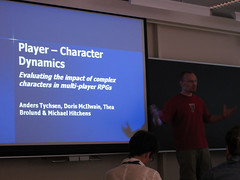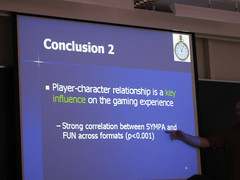Player Character Dynamics in Multi-player Role playing games. Anders Tychsen, Ken Newman, Thea Brolund and Michael Hitchens.
This paper is of immediate use for my own research.
The empirical study supports that the player’s engagement in the player character is key for enjoyment in a multi player role playing game that highly complex player characters are not a problem for the player, and that players in fact, despite complexity, tend to use all features of the player character. Furthermore the results of their study indicate that likeness between the player’s own personality and the avatars doesn’t have impact on the experience: both avatars very alike the players themselves and very different was fun to play. That’s something I have wondered for years, if it is so or not. There are studies showing that people tend to create avatar that are visually alike themselves in virtual worlds, though but that trend doesn’t say anything about the actual enjoyment. I have used the design stance to let the player choose whether s/he makes the character alike or not, assuming that it depends on the mood of the day, the game, and on whether the player want to role play or not.
I’m happy that this study was made – now I can lean on it and make my previous assumptions to more supported statements. Whee!
I realize thought, after having read the paper in the proceedings, that I took for granted that the personality was actually implemented into the character stats, but in the paper it says it was used as role playing notes and as material in the description part of the character sheet. (//meaning I can’t use the results straight away since didn’t use a functional integrated avatar personality in the CRPG) So ill need to email Anders about that, and also ask him about some figures in the tables to make sure I haven’t misunderstood their findings.
Freeform notes I threw down while listening:
Results of the study. Focusing on typical games.
Using EPAQ model for defining personality (of the real player? How use. Ok – just said: using those in the game story in the game world. Then exactly the same character template. D20.
Example characters. Polarised and rounded.
Tried different model, long evaluation. FUN model modified from Newman worked best in their setting.
No correlation between personality of character and player!
Not negative if very different!
No indication that complexity was negative!
Player-character relationship is key influence!
Use: they used all features they could find.
No role play in the digital setting. However! If there is background info on character it is always used!
When they communicate with gm in digital – then they role-play! Only lasts as long as gm is present.
Larger set of character features enhances engagement.
//actually: Maybe make a GM:d test of WoM?
QA
Q: you mean game designers are wrong.
A: nonono
//..But how transcribe EPAC model to d20?
Michael Nitsche: to what extent did the study look at the quality of the RPG? Abstraction layer?
Jaakko: how do you measure player-character relationship?
A: in the paper. We tried to capture as many variables as possible.
Tanya: Fable. Would be interesting to look at single player games too.
Michael, yes Planescape Torment

